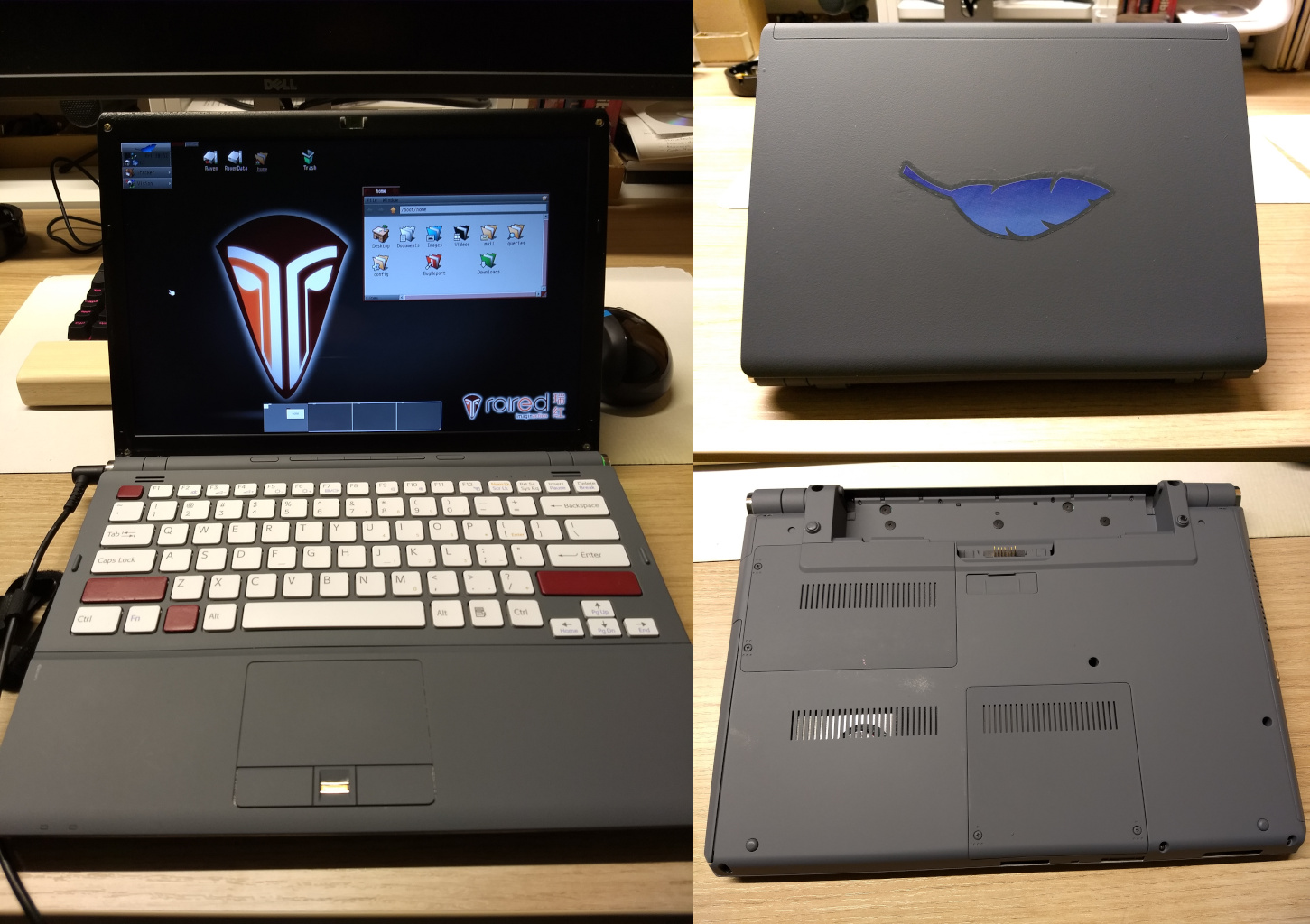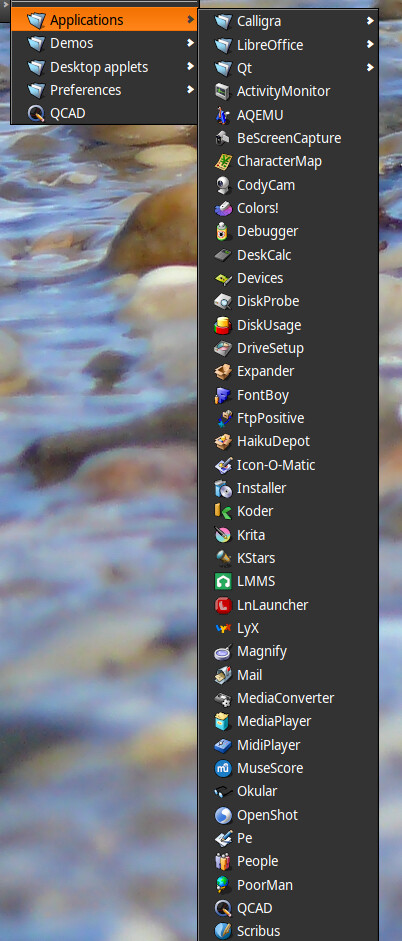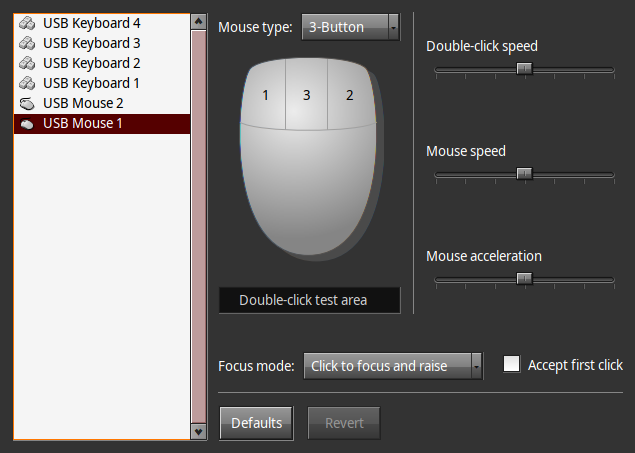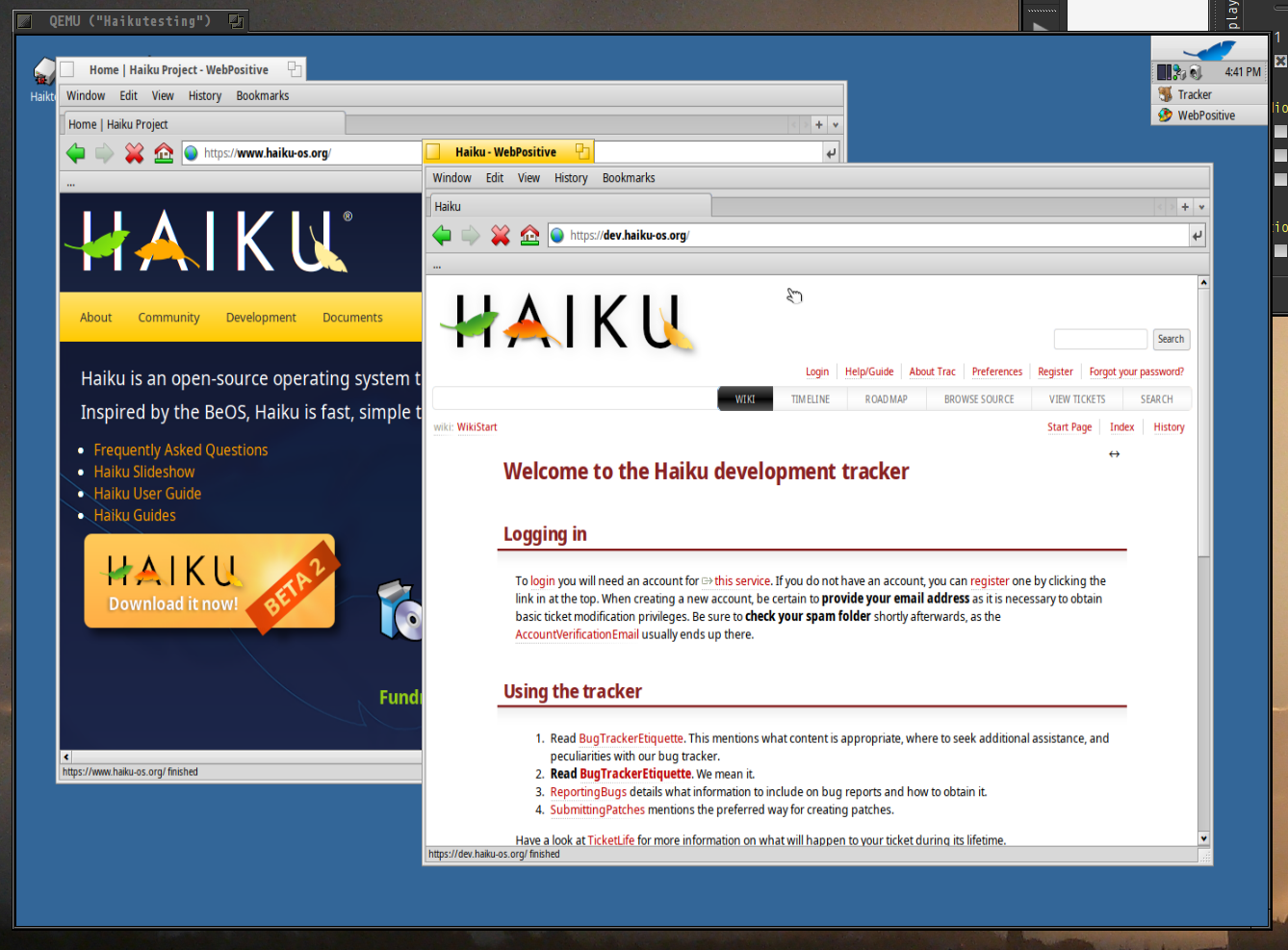Wondering why Wonderbrush is not in the list, it seems to be nice for the case of Hand painting and Vector Graphics
Probably because roiredxsoto is using Haiku x64 and, at the time he wrote this the package wasn’t available. Even now that it is, there are still crashes using 64bits version.
Good day,
@nephele, Wonderbrush is not on the list because when I started this (as @Starcrasher pointed out) it wasn’t available for x64. I only use Haiku x64, and am interested in the ARM port (and ther RISC-V one, just for the curiosity, not that I have a RISC-V board).
The switching process is still on track. While I was planning to be on vacation from 18th, that didn’t happen, so walking through the track is going slow.
The QEMU/AQEMU test is not yet finished, but the first contact was somewhat successful with MacOS 9. Wish these days I’ll be able to do the same with the linux distro and report properly, also including network access as pointed out by @Diver. I’ll test it, and hope it succeeds too. Then, of course, should write a small tutorial on how I got those to work.
I’ve been doing some changes lately that hopefully will be completed by the end of the holidays, at least I expect some of them to reach completion, and will report. These have kept me away from Godot game development for some time, also from reporting Godot’s issues on Haiku. In fact, I wasn’t able to turn on the Haiku box at work for the past weeks (four weeks already?).
Nonetheless, the switching is on the way and here is the plan:
- back up the files I have in the hard drives to an external drive (game projects, art, …)
- remove all internal drives
- plug in an SSD drive and install Windows (I’ll be testing this weekend running Windows from external drive, but for printing photos -yep, I rather have prints than digital- it will be more than enough)
- remove Windows SSD to external USB case
- plug in an SSD drive and install Linux (will be KDE based distro. KDE seems to be the most responsive at the moment, and Qt is well supported on Haiku which will allow writing stuff on Haiku that runs on the Pinephone with a KDE/Qt based OS)
- remove Linux SSD to external USB case
- plug in an SSD drive and install Haiku. This will be the default boot drive as no other OS will be on the box
- plug in an HDD and transfer the backed up files to this drive. I’m not sure yet what configuration should give to this drive, but as of now, I’m thinking of 2 partitions, one with BeFS and other with NTFS? for easy access from Win/Lin, and sharing stuff.
All the installs will be clean installs. That is why I was testing the QEMU/AQEMU virtualization, so I could run some stuff off the VM’s. If the Linux VM test is successful, maybe tomorrow?, this will be a GO. Will need reporting as well. One of the VMs will be Haiku, so I can test stuff without messing the working OS. I did run VM’s with Haiku as host, being Haiku virtualized in Gnome Boxes, but with issues, non productive by any means 


This will mean that, in order to finish the game I’m working on now, I’ll have to boot from the Linux external drive, as Godot is yet hard to use on Haiku (I know I need to report this, thus one of the reasons for making the switch now). As the game is far from an AAA title, it won’t be a problem! (I guess?)


As @extrowerk pointed out, AQEMU/QEMU docs is a must, though I found other interesting stuff elsewhere, therefore later I’ll sum up and post as it was far from trivial to get MacOS working. This is another case where RTFM is a must. 


It’s not going to be an easy task, and I know I might need to use Linux/Windows often at the beginning to get some things done but, then again, the only way to do things is doing them.
Let’s see how it goes and if we can get a nice tutorial out of this experience.
Regards,
RR
Arrgh! I’m disappointed. ![]()
As we say here: Bon courage
Good day,
I just carried out some test today:

Running MacOS 9, latest Haiku hrev and KDE Neon on VM, using Haiku as Host. All from an USB 3.0 pendrive. Actually, on KDE Neon can run Firefox, but without network access at the moment. Need to find the fix.
Also, Haiku and MacOS 9 are quite responsive, KDE Neon, not so much, the KDE Neon VM does not keep some settings from boot to boot. I need to figure out how to do it and figure out how to improve the speed.
Nonetheless, not bad experience. Took quite long to install KDE Neon, though I also presume that the fact that I was downloading Haiku ISO had something to do with it. Also, KDE Neon was “snappier” when I closed the other VMs (Haiku and MacOS 9).
Regarding this, 2 tasks left:
1- Get network working (need to get on with @Diver’s suggestion)
2- Get Linux distro to behave better (improve the VM performance)
And an extra task, tell QEMU to start the VM at the right resolution without scaling the display. Finally end up with homework again XD
Regards,
RR
I made it on Unity and porting it to Godot, simple crayon-style… quite far from AAA





Regards,
RR
Good day,
This weekend is switching time, so today I just completed STAGE1, the “easiest” one:
Before:
Got the old Sony Vaio VGN-SR19XN (Vaio VGN-SR19XN hardware compatibility topic), from 2018 where @extrowerk replied to every sentence I wrote with “Create a ticket”  and at that time I had no idea what a ticket was, I mean, regarding Haiku.
and at that time I had no idea what a ticket was, I mean, regarding Haiku.
And turned that old Vaio into this, I introduce you the Raven:

Need to get a working battery for this laptop though as the original one is dead. on the other hand, I lost the Wifi/Bluetooth switch on the disassembling/reassembling stuff.
Actually, now the keyboard works, it’s an US International one with some tuned keycaps and no Win key, the Super key is Roired’s Red. I found out that the battery was dead thanks to Haiku, also that the DVD player was faulty, so I replaced the HD witn an SSD and put the HD in the DVD tray. The rest is just some paint job that served as a Betatesting for future jobs, as it has some flaws.
With Haiku on the SSD is quite fast and really usable now. If finally the VGA out ends up working, it will be a nice “show off” at meetings. If not, will use a pendrive with some light linux distro.
Tomorrow the BIG SWITCH (the production desktop) will start. Let’s hope everything goes smooth and I can finish within the weekend. Will post the result.
Regards,
RR
I am frequently a duck, sorry about that.
(I mistyped it, deliberately.)
Nice Haiku sticker, btw. Good luck to the BIG SWITCH.
Also how it is off-topic?
Before … After. It makes me think about tv shows about car customisation. Those where the client comes with a wreck and when he’s back to the garage a year later, he can’t recognize his car. 
No kidding, the beast looks great. Nice job you did there!
Indeed! And without handing over a sack of cash either… ![]()
Good day,
@extrowerk, no need to sorry, being you a Luck, I’ll ask you the next winning lottery numbers, just in case… 
The Haiku sticker is part of the ones I made for BeGeistert 2019 IIRC, I kept 5, now only 1 left. I should think of a Version 1.1 of the sticker for this year.
This is “off-topic” because I couldn’t find a category that fit this topic, from my point of view 


@Starcrasher, looks better on pic than real… paint job mistakes are not so obvious on the pics… 

@humdinger, total cost of this “pimp my laptop”:
- SSD Kingston A400 240GB: 28 € (local shop)
- Vaio US international keyboard: 13 € (aliexpress)
- HD adapter for DVD tray: 7€ (local shop)
- Black paint spray: 7 € (local shop)
- Red paint spray: 5 € (local shop)
- Cement Grey paint spray: 2x 8€ (local shop)
Total cost: 76€ and losing the Wifi/Bluetooth switch

Still need to get a working battery though.
Another lesson I learnt from this is: never again buy any laptop that does not have a full service manual freely available (it won’t happen in the near future, the Raven seems fine ATM). It was a PITA to find stuff on how to disassemble this. Until now I have some brands that will never, ever, again enter my environments: Apple, Asus and after my experience with this Vaio, Sony (thanks to youtube for some helping videos on this Vaio laptop, nothing to worry though as Sony does not sell laptops any more), being crApple the worst of them.
All right, see ya after the switch.
Regards,
RR
It was 2018 in Hamburg germany. I have the same on my laptop.
Oh, strange to hear. I have had very good experience with my P8 (P67-M) ASUS motherboard working with HAIKU…
Good day,
2018??? Damn!!! Time flies!!! 


Regards,
RR
Good day,
I was referring to devices, not parts. Asus displays and tablets to be more specific.  Just the same as crapple hardware.
Just the same as crapple hardware. 
Regards,
RR
Good day,
Back in August 2020 I started this post (Off-Topic), while in the process of “switching to Haiku”, where I made a list with the “equivalent” software moving from Linux, which is what I was mostly using at that time, and Windows, which I used for printing and scanning. At that time I had the PC triple booting Haiku, Linux and Windows. Now there is only Haiku on this box, as well as on the laptop that I pimped as shown in a prior post.
DISCLAIMER:
What I did here “fits” my needs at the moment. It might not fit yours, so if you try to do the same, beware. First do your research, ask, analise, test, hit your head against the wall… I am quite aware of the limitations I’m going to face from now on when using Haiku as a daily driver, though eventually all of them will get reduced sooner or later.
This process took longer than expected because of the pimping, first the laptop, then the desktop. Doing paint jobs with sprays is not “clean” at home if you don’t have a place that can get dirty. Then the tweaking, even today I’m yet to have the tweaking complete… patience little grasshopper.
I still need to keep some way of booting Windows and Linux for being able to use certain hardware and also for testing Videogames on those platforms. So I came to the “best solution ever”, remove all disks from the PC and put them inside USB cases, and boot each OS from its USB case but Haiku that would be the only OS on Baremetal.
Before doing anything I did backup every stuff onto an external drive. Way too much to loose whatever.
Windows:
I just followed the guide of some genius on the internet who said that I just needed to install Windows onto the hard drive, connected to the mobo, then take it out and put it in the USB case and boot. Easy. Problem, some dumbasses believed that (me, myself and I). Once done, Windows wouldn’t boot from the USB drive, only from internal SATA connector.
After doing proper research, used Rufus to install Windows to an external USB drive. Done.
So Windows took me a whole weekend, first install everything into the SATA drive (the OS, the software, the data) and do some tests with the hardware and drivers. Put the drive in the case, and try again and again until realized that such approach is flawed. Then do the same after Rufusizing the USB drive, installing and testing. At the moment I can say that so long so good, though to be honest, I don’t use Windows that much. It’s working quite ok, at least for now. We will see what happens in the near future.
Linux:
I had been using Fedora Silverblue for the last year with some issues. Random locks of the OS requiring hard reset, and some issues too with the Huion Pen digitizer. So I decided to check out other options. The idea behind Silverblue’s desing appeals to me, so I tried another take at it, OpenSUSE MicroOS. I have been an OpenSUSE user before so I did try it. It didn’t satisfy me that much, though it does look promising, and I’ll might get back at it when it’s a bit more mature.
The advantage of Linux (also Haiku) is that it can be installed directly to an external USB drive without problems. I did some tests and end up with OpenSUSE Leap at the moment. When MicroOS becomes better I might switch to that, we will see.
Linux install went without issues, as expected, and after first install no problems to boot, just the regular “codecs” issue. Added the software and the data. Done.
Haiku:
Besides Baremetal, I also installed Haiku on another external USB drive for testing purposes. Testing on the “production” machine can be very harmfull to data, so I decided to have the “production” machine on bare metal, and when I want to test something, do it against the external Haiku install. As with OpenSUSE, installing Haiku went without issues, and quite fast. Then add the software and the data. Now the only thing left to do is tweaking. Still need to add fonts and whatnot.
While Haiku install was the quickest, there are some quirks that I experienced, like having two QCad entries in the Applications menu:

The Tracker status window went crazy when copying back the data:

And now, the input preferences shows (it did before) two mice and four keyboards:

I haven’t tested everything yet. The digitizer is not tested nor plugging the phone nor the camera to Haiku. Finally I got FuseSMB working. The issue was with FuseSMB settings and SMB protocol. Had to add “client min protocol = NT1” to the fusesmb.conf file (at the end of the file), and now it works.
Performance from USB has been quite good. Windows and Linux external drives are SSDs on USB 3.0 UASP cases, connected to USB 3.1 gen2, so presumably there will be no bottleneck there. We will see what happens when I do record audio, maybe it’ll hold, maybe it’ll fall. But performance has been almost as good as internal, or at least I can’t see much difference, neither on boot times nor on app launching.
From now on, let’s see if I can do something nice on Haiku. For starters I just set myself three topics to “focus” on:
0- Improve my overall knowledge of Haiku
1- Godot on Haiku.
I’ll help with the testing as I use it, and report any issues.
Goal: Complete a game on Haiku with Godot (without audio as I have no audio in nor out ATM)
2- Git
I need to improve my knowledge on Git so I won’t make a mess as I did before when working on Gamejectder (messed branches, files, master, whatever… in the end I didn’t know what I had done with everything XD).
Goal: make everything I may do available on GitLab
3- Python
Need to improve my knowledge on Python to be able to code some tools I need for Gamedev, and for some daily tasks. Python bindings for Haiku API might be on the list, though I’m not confident right now (lack of knowledge and time)
Goal: code some useful tools with PyQt, or even better, with the Haiku API
And this is the family pic when I completed the fresh install of Haiku, before starting to install software and tweaking. The Deskbar is already on its final location so it’s not seen in the pic:

Let’s se if I can come up with something good for Haiku.
Regards,
RR
PS.: By the way, I can’t change the topic to “Switched (Switching) to Haiku”, or at least I can’t find how to do it. If the forum ops can, I would appreciate it. Thanks.
Not Haiku related, but wanted to say that your desktop-case looks awesome!!! It’s a Mini/ITX?
Good day @un_spacyar,
True, it’s a miniITX case, quite small. Paint job is only on the outside. It’s “native” color is black. It’s the Sharkoon QB One, simple and not expensive. 
Regards,
RR
Good day,
Well, step by step we are gaining knowledge. Finally I got networking working on QEMU with Haiku as Host and also Haiku as Guest:

Image shows Webpositive inside the VM with networking access. And here, Firefox running on KDE Neon with network access inside QEMU:

I need to fix some issues before writing the tutorial some people asked for. Hopefully will be in the next weeks? 
KDE Neon is still too slow to be usable. So I need to find a resource savvy linux distro that runs Firefox, or other “modern” browser. 
Regards,
RR
If KDE Neon is too heavy for QEMU, just try Puppy Linux, it runs in RAM, some links:
Also, to run Puppy as virtual machine within other systems:
Happy hacking!!!
